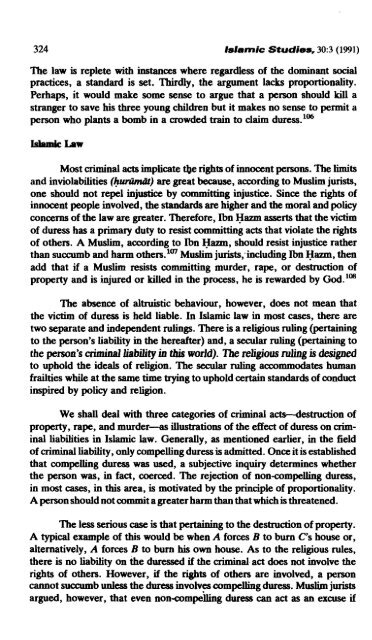LAW OF DURESS IN ISLAMIC LAW AND COMMON LAW: A ...
LAW OF DURESS IN ISLAMIC LAW AND COMMON LAW: A ...
LAW OF DURESS IN ISLAMIC LAW AND COMMON LAW: A ...
Create successful ePaper yourself
Turn your PDF publications into a flip-book with our unique Google optimized e-Paper software.
324 Islamic Studies, 30:3 (1991)<br />
The law is replete with instances where regardless of the dominant social<br />
practices, a standard is set. Thirdly, the argument lacks proportionality.<br />
Perhaps, it would make some sense to argue that a person should kill a<br />
stranger to save his three young children but it makes no sense to permit a<br />
person who plants a bomb in a crowded train to claim duress.'"<br />
Most criminal acts implicate @e rights of innocent persons. The limits<br />
and inviolabilities (hwzlmdt) are great because, according to Muslim jurists,<br />
one should not repel injustice by committing injustice. Since the rights of<br />
innocent people involved, the standards are higher and the moral and policy<br />
concerns of the law are greater. Therefore, Ibn Hazat asserts that the victim<br />
of duress has a primary duty to resist committing acts that violate the rights<br />
of others. A Muslim, according to Ibn Hazm, should resist injustice rather<br />
than succumb and harm others.107 Muslim jurists,including Ibn Hazm, then<br />
add that if a Muslim resists committing murder, rape, or destruction of<br />
property and is injured or killed in the process, he is rewarded by ~od.'<br />
The absence of altruistic behaviour, however, does not mean that<br />
the victim of duress is held liable. In Islamic law in most cases, there are<br />
two separate and independent rulings. There is a religious ruling (pertaining<br />
to the person's liability in the hereafter) and, a secular ruling (pertaining to<br />
the person's criminal liability in this world). The religious xuling is designed<br />
to uphold the ideals of religion. The secular ruling accommodates human<br />
frailties while at the same time trying to uphold certain standards of conduct<br />
inspired by policy and religion.<br />
We shall deal with three categories of criminal adestruction of<br />
property, rape, and murder-+ illustrations of the effect of duress on crim-<br />
inal liabilities in Islamic law. Generally, as mentioned earlier, in the field<br />
of criminal liability, only compelling duress is admitted. Once it is established<br />
that compelling duress was used, a subjective inquiq determines whether<br />
the person was, in fact, coerced. The rejection of non-compelling duress,<br />
in most cases, in this area, is motivated by the principle of proportionality.<br />
A person should not commit a greater harm than that which is threatened.<br />
The less serious case is that pertaining to the destruction of property.<br />
A typical example of this would be when A forces B to burn C's house or,<br />
alternatively, A forces B to burn his own house. As to the religious rules,<br />
there is no liability on the dwessed if the criminal- act does not involve the<br />
rights of others. However, if the rights of others are involved, a person<br />
cannot succumb unless the duress involves compelling duress. Muslim jurists<br />
argued, however, that even non-com~lling duress can act as an excuse if
















